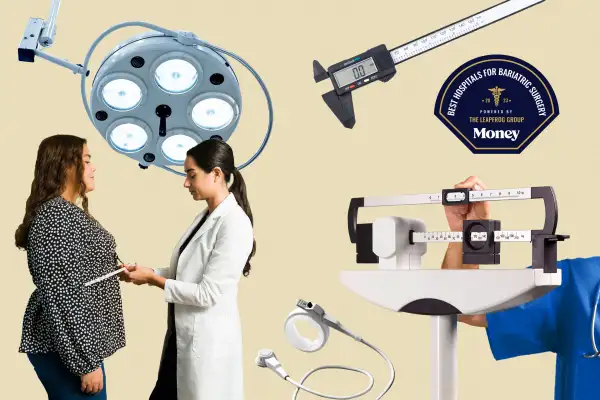Methodology: Best Hospitals for Bariatric Surgery

The Leapfrog Group is a nonprofit organization that aims to help consumers make informed decisions about their health and access safe, high-value care. For over two decades, it has collected and published data on patient safety and quality of care from voluntary surveys and other sources. More than 2,200 hospitals and surgery centers completed its flagship Leapfrog Surveys in 2022.
To compile the list for the Best Hospitals for Bariatric Surgery list, the following criteria were applied (criteria applies to all hospital types unless indicated otherwise):
1.Bariatric Surgery for Weight Loss: A hospital must achieve Leapfrog’s standard for bariatric surgery
Three decades of research have consistently demonstrated that patients that have their high-risk surgery at a hospital and by a surgeon that have more experience with the procedure have better outcomes, including lower mortality rates, lower complication rates, and a shorter length of stay than for patients who have their surgery done at a hospital or by a surgeon with less experience. Bariatric surgery for weight loss is among eleven high-risk procedures selected for by Leapfrog and its national expert panel for its strong volume-outcome relationship based on the research by Dartmouth-Hitchcock Medical Center, Michigan Medicine, and Johns Hopkins Medicine. For more information, click here.
There are several different types of bariatric surgery for weight loss, including gastric sleeve surgery, gastric bypass, and lap band surgery. Leapfrog’s standard for bariatric surgery for weight loss measures whether a hospital’s annual volume of bariatric surgeries meets or exceeds a minimum volume standard of fifty (50) and whether the hospital’s privileging process includes the surgeon meeting or exceeding Leapfrog's minimum surgeon volume standard of twenty (20). Hospitals also report on whether they have protocols in place to ensure that the surgery is not performed unnecessarily on patients who would not benefit.
2. Safe Surgery Checklist: A hospital must achieve Leapfrog’s standard for a Safe Surgery Checklist
Experts agree using a Safe Surgery Checklist, a protocol that ensures the whole surgical team is engaged in performing key safety checks at every critical phase of a procedure (such as confirming the surgical site and anticipating critical events), improves patient outcomes after procedures and saves lives. Hospitals report on whether all important elements of a safe surgical checklist are used with every procedure. For more information, click here.
Leapfrog’s safe surgery checklist standard measures the extent to which hospitals use a safe surgery checklist and whether elements of the checklist are documented and used on every patient undergoing an applicable procedure based on an audit of sampled patients. Specifically, hospitals achieving the standard must:
- Use a safe surgery checklist on all patients undergoing an applicable procedure
- Have a checklist that includes all safe surgery checklist elements (ADD), and these elements are verbalized in the presence of the appropriate personnel
- Complete an audit of at least 15 patients and document adherence to the checklist
- Document adherence to the checklist for at least 90% of the patients included in the audit
3. Healthcare-Associated Infections: A hospital must have less than the expected number of infections for central-line associated blood stream infections and catheter-associated urinary tract infections.
Note: This criterion does not apply to hospitals that were unable to have a standardized infection ratio calculated.
Healthcare-Associated Infections (HAIs) are infections that were not present when a patient was admitted to the hospital but develop in the hospital as the result of poor infection control. Patients with central lines (which are used to deliver medication and other treatments) are at a high risk for a dangerous infection in the blood and patients with catheters are at a risk for developing a dangerous infection in the urinary tract. These serious infections can lead to other complications, increase recovery time, and can often lead to death. For more information, click here.
To assess healthcare-associated infections, Leapfrog uses a standardized infection ratio which compares the number of infections that actually occurred at the hospital to the number of infections expected for the hospital, given the number of central lines or catheters used and other factors like facility type and size. A number lower than one means fewer infections than expected.
4. Hospitals eligible for a Leapfrog Hospital Safety Grade must receive an A or B on the letter grades publicly reported at the time of the Best Hospital List public announcement.
Note: This criterion does not apply to hospitals that are not eligible for a Safety Grade, such as pediatric hospitals, military treatment facilities, specialty facilities, critical access hospitals, etc.
The Leapfrog Hospital Safety Grade assesses how safe hospitals are for patients. Each A, B, C, D or F score comes from expert analysis of publicly available data consumers can use to protect their families from harm or death during a hospital stay. Some hospitals are exempted from receiving a Safety Grade, including specialty hospitals like children’s or surgical, and Critical Access Hospitals. Hospitals that are eligible for a grade, which includes general acute-care hospitals, must receive an A or B on the current Leapfrog Hospital Safety Grade (fall 2022) in order to qualify for the list of Best Hospitals for Bariatric Surgery for Weight Loss.